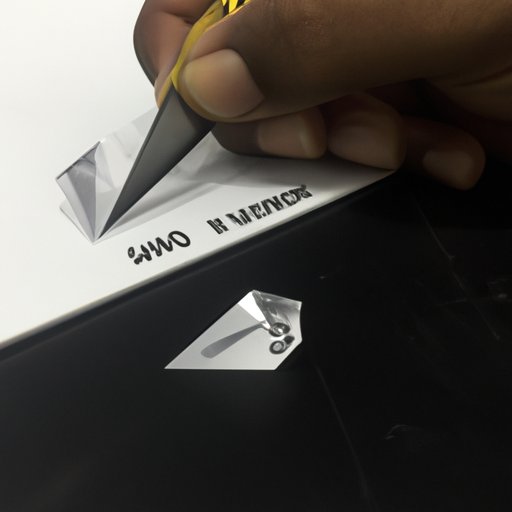Introduction
A carat diamond is a unit of measurement used to describe the size of a diamond. One carat is equal to 0.2 grams, or 200 milligrams. When it comes to diamonds, bigger is not always better, and a one-carat diamond can vary in size depending on the other factors that make up the diamond’s characteristics such as its cut, shape, and setting.

Overview of the Size of a Carat Diamond
The size of a carat diamond depends on several factors, including its carat weight, cut grade, shape, and setting. A one-carat diamond can appear larger or smaller than its actual size due to the other characteristics that make up the diamond. For example, a one-carat round brilliant cut diamond will appear larger than a one-carat princess cut diamond because of its shape.

How to Determine the Size of a Carat Diamond
When determining the size of a carat diamond, it is important to consider the following factors:
Carat Weight
The carat weight of a diamond refers to the total weight of the diamond, measured in carats. The higher the carat weight, the larger the diamond. However, it is important to note that two diamonds of the same carat weight can look very different in size due to the other factors that make up the diamond.
Cut Grade
The cut grade of a diamond refers to the quality of the cut of the diamond. A well-cut diamond will reflect light and sparkle more, making it appear larger than a poorly cut diamond of the same carat weight. A diamond with a higher cut grade will also appear larger than a diamond with a lower cut grade.
Shape and Setting
The shape and setting of a diamond can also affect its appearance. A round brilliant cut diamond will usually appear larger than a princess cut diamond of the same carat weight. Similarly, a diamond set in a halo setting will appear larger than an unset diamond.
Pros and Cons of Buying a One-Carat Diamond
Buying a one-carat diamond has both advantages and disadvantages. Here are some of the pros and cons to consider when purchasing a one-carat diamond:
Pros
- A one-carat diamond is the perfect size for an engagement ring.
- It is large enough to be noticed, but not too large to be ostentatious.
- It is a good size for those looking for a diamond with a good value.
Cons
- It can be difficult to find a one-carat diamond that is of good quality.
- The price of a one-carat diamond can be quite expensive.
- It may not be suitable for those who prefer a larger diamond.
Comparison of Different Cut Sizes of a Carat Diamond
The size of a one-carat diamond can vary depending on the cut. Here is a comparison of the different cut sizes of a one-carat diamond:
Round Brilliant Cut
The round brilliant cut is the most popular cut for diamonds and is considered the ideal cut for maximizing brilliance and sparkle. A one-carat round brilliant cut diamond typically measures 6.5mm in diameter.
Princess Cut
The princess cut is a square cut diamond with pointed corners. A one-carat princess cut diamond typically measures 5.5mm x 5.5mm.
Cushion Cut
The cushion cut is a square cut diamond with rounded corners. A one-carat cushion cut diamond typically measures 6.1mm x 6.1mm.
Emerald Cut
The emerald cut is a rectangular cut diamond with stepped facets. A one-carat emerald cut diamond typically measures 6.5mm x 5mm.
Marquise Cut
The marquise cut is a boat-shaped cut diamond with pointed ends. A one-carat marquise cut diamond typically measures 8mm x 4mm.

Analysis of the Price Point for a Carat Diamond
The price point of a one-carat diamond can vary depending on several factors, including its carat weight, cut grade, clarity, color, and certification. Here are some common price points for a one-carat diamond:
Factors That Affect the Price
- Carat weight: The higher the carat weight, the more expensive the diamond.
- Cut grade: A diamond with a higher cut grade will cost more than one with a lower cut grade.
- Clarity: The higher the clarity, the more expensive the diamond.
- Color: A diamond with a higher color grade will cost more than one with a lower color grade.
- Certification: A diamond with a certificate from a reputable laboratory will cost more than one without a certificate.
Common Price Points
On average, a one-carat diamond can range in price from $2,000 to $15,000, depending on the factors mentioned above. It is important to note that the price of a one-carat diamond can vary greatly from retailer to retailer, so it is important to compare prices across different vendors.
How to Get the Most Value from a Carat Diamond Purchase
When buying a one-carat diamond, it is important to consider quality over quantity. Here are some tips on how to get the most value from your purchase:
Consider Quality Over Quantity
When shopping for a one-carat diamond, it is important to consider the quality of the diamond rather than the size. A high-quality one-carat diamond is more valuable than a lower-quality larger diamond.
Buy from Reputable Retailers
It is important to buy from a reputable retailer who offers certified diamonds. This ensures that the diamond you are buying is authentic and of the highest quality.
Compare Prices Across Different Vendors
It is important to compare prices across different vendors to ensure you are getting the best deal. Be sure to compare the quality of the diamonds as well as the prices.
Conclusion
In conclusion, a one-carat diamond is a popular choice for those looking for a diamond of good value. The size of a one-carat diamond depends on its carat weight, cut grade, shape, and setting. It is important to consider quality over quantity when buying a one-carat diamond, and to buy from reputable retailers and compare prices across different vendors to get the most value from your purchase.


